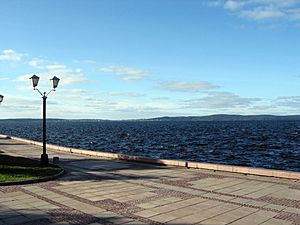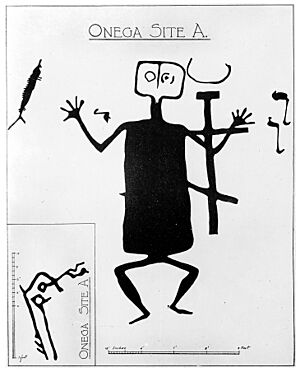Lake Onega facts for kids
Lake Onega is a very large lake located in the northwest part of Russia. It is the second largest lake in Europe, right after Lake Ladoga. This amazing lake is known for its clear waters, many islands, and ancient history.
Contents
Discovering Lake Onega
Lake Onega is a freshwater lake that plays an important role in the region. It is a popular spot for both nature lovers and those interested in history. The lake's name comes from the Finnic languages, possibly meaning "large body of water" or "lake with many islands."
Where is Lake Onega?
This huge lake stretches across several regions in Russia. It is mainly found in the Republic of Karelia, but parts of it also reach into Leningrad Oblast and Vologda Oblast. The city of Petrozavodsk, the capital of Karelia, is located right on the western shore of Lake Onega.
How Lake Onega Formed
Lake Onega was formed a very long time ago by massive glaciers. As these huge sheets of ice moved across the land, they carved out the deep basin that now holds the lake's water. When the glaciers melted, they filled this basin, creating the lake we see today. This process also left behind many rocks and hills around the lake.
Islands and Ancient History
Lake Onega has more than 1,650 islands! Many of these islands are small, but some are quite large and hold special historical treasures. The most famous island is Kizhi, known for its incredible wooden churches.
The Famous Kizhi Island
Kizhi Island is a UNESCO World Heritage site. It is home to the Kizhi Pogost, which is an amazing collection of old wooden churches and other buildings. These structures were built without a single nail, using only traditional carpentry methods. The most famous buildings are the Church of the Transfiguration and the Church of the Intercession. They show incredible skill from builders hundreds of years ago.
Ancient Art: Onega Petroglyphs
Around the shores of Lake Onega, especially on the eastern side, you can find ancient rock carvings called petroglyphs. These carvings were made by people living in the area thousands of years ago, during the Stone Age and Bronze Age. They show figures of humans, animals, and mysterious symbols. These petroglyphs give us clues about the beliefs and daily lives of these early communities.
Rivers Flowing In and Out
Many rivers flow into Lake Onega, bringing water from the surrounding lands. Some of the main rivers that feed the lake include the Shuya, Suna, Vodla, and Vytegra. Only one river flows out of Lake Onega: the Svir River. The Svir River connects Lake Onega to Lake Ladoga, which then flows into the Neva River and finally into the Baltic Sea. This makes Lake Onega part of a larger water system.
Life in and Around the Lake
Lake Onega is home to many different kinds of plants and animals. Its waters are rich in fish, including salmon, pike, perch, and whitefish. These fish are important for both local fishing and the lake's ecosystem. The areas around the lake are covered with forests, which provide homes for animals like bears, moose, and various birds. The lake's environment is carefully watched to protect its natural beauty and wildlife.
Using the Lake: Transport and Fun
Lake Onega is not just a beautiful natural wonder; it is also important for transportation and recreation. It is part of the Volga–Baltic Waterway, a system of rivers and canals that allows ships to travel from the Baltic Sea to the Volga River. This makes the lake a busy route for cargo ships and passenger boats.
The lake is also a popular place for tourism. People enjoy boating, fishing, and exploring the many islands. In winter, when the lake freezes over, ice fishing and other winter sports become popular. The towns and villages along its shores, like Petrozavodsk and Kondopoga, welcome visitors who come to enjoy the lake's beauty and history.
Images for kids
See also
 In Spanish: Lago Onega para niños
In Spanish: Lago Onega para niños







